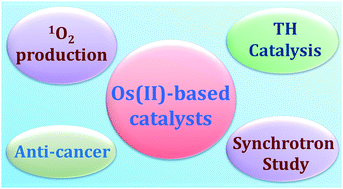Os(ii) complexes for catalytic anticancer therapy: recent update
Abstract
The recent dramatic enhancement in cancer-related mortality and the drawbacks (side effects and resistance) of Pt-based first-generation chemotherapeutics have escalated the need for new cancer medicines with unique anticancer activities for better human life. To overcome the demerits of Pt-based cancer drugs, the concept of catalytic anticancer agents has recently been presented in the field of anticancer metallodrug development research. Many intracellular transformations in cancer cells are catalyzed by metal complexes, including pyruvate reduction to lactate, NAD(P)+ reduction to NAD(P)H and vice versa, and the conversion of 3O2 to reactive oxygen species (ROS). These artificial in-cell changes with non-toxic and catalytic dosages of metal complexes have been shown to disrupt several essential intracellular processes which ultimately cause cell death. This new approach could develop potent next-generation catalytic anticancer drugs. In this context, recently, several 16/18 electron Os(II)-based complexes have shown promising catalytic anticancer activities with unique anticancer mechanisms. Herein, we have delineated the catalytic anticancer activity of Os(II) complexes from a critical viewpoint. These catalysts are reported to induce the in-cell catalytic transfer hydrogenation of pyruvate and important quinones to create metabolic disorder and photocatalytic ROS generation for oxidative stress generation in cancer cells. Overall, these Os(II) catalysts have the potential to be novel catalytic cancer drugs with new anticancer mechanisms.



 Please wait while we load your content...
Please wait while we load your content...